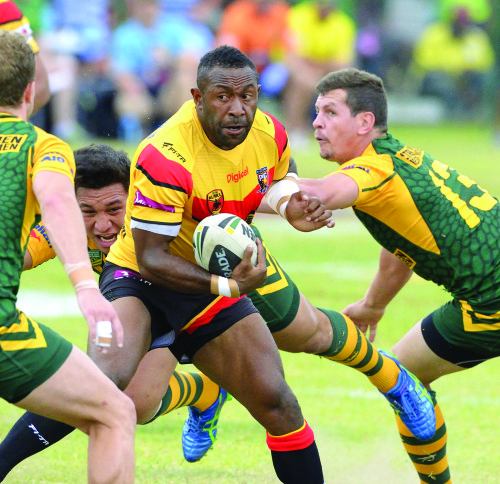How rugby league has become a national obsession in Papua New Guinea, reports Dorian Mode.
I love rugby league. Played it at school. Played it at uni. Indeed, when I was a student at the Sydney Conservatorium of Music I formed the first-ever rugby league team there called the Mozart Maulers. Our team comprised mostly brass players in the forwards and string players in the backs.
In our inaugural game we defeated the premiers, Sydney University, 24–20. In fact, such was the intensity of the game, one of the opposition players was knocked unconscious
in the final minutes. No one was more surprised than the Conservatorium with its surprise victory. We thought we were on a Haydn to nothing (groan). Anyway, I wrote a funny book about it, aptly titled, The Mozart Maulers.
But if you think I’m a fan of the game, I’ve got nothing on fans in the Pacific. Rugby league isn’t simply the most popular team sport in Papua New Guinea, it’s the national religion. Indeed, don’t be surprised if the local bishop arrives at mass with his cassock trimmed in team colours. PNG is rugby league crazy.
History of rugby league in PNG
Rugby league first gained ascendency in PNG in the 1930s, when Australian gold miners were prospecting in the remote jungles of New Guinea and kicked a ball around in their downtime. Australia’s relationship with New Guinea galvanised during World War 2, especially during the battles of Kokoda, Milne Bay and Rabaul. It’s during this period, locals adopted the game as their own. 
As the game’s popularity as a spectator sport grew in the 1960s, it was still largely played by ex-pat Aussies. However, during the following decade participation in the sport blossomed, and in 1974 Papua New Guinea became a member of the Rugby League International Federation. The following year the national team played Great Britain, losing 40–12. Ten years later and the national team – the Kumuls (bird of paradise in Tok Pisin) – were competing in the Rugby League World Cup. PNG footy had arrived on the world stage.
In the 1990s, a national competition was created: The SP Inter-City Cup. In 2005 the SP Inter-City Cup was revamped into the new look Papua New Guinea National Rugby League (PNGNRL). This competition comprises nine teams from cities and provinces in PNG, all vying for the SP Cup. The competition is modelled on the Australian NRL format, with 26 round-robin games followed by the top four sides in play-offs. (In 2007 a new league called the Nokondi Cup was created for teams in the Eastern Highlands province.)
Like most professional leagues, below the primary competition exist numerous local and provincial teams and subsequent competitions, which in turn become feeder clubs for the main competition. The most notable team is the Port Moresby Vipers, which competed in the Australian Panasonic Cup in 1986, 1987, 1988 and 1989; and in the Queensland Cup competition in 1996 and 1997.
The new millennium
Rugby league has become so intrinsic to PNG that Sir Michael Somare launched an official bid for a PNG team to join the Australian National Rugby League in October 2008.
Numerous Papua New Guineans have gone on to play professional rugby league either in the National Rugby League in Australia or Super League in Europe. Adrian Lam (who captained the Queensland state-of-origin side), Neville Costigan and Marcus Bai are but a few of the stellar players to become household names in Australia.
I speak with former Canberra Raiders halfback/five-eighth (1993-96), Mark Mom. He is the NRL’s in-country general manager in PNG, delivering the League Bilong Laif development program. Besides playing in the NRL, he first played for PNG competing in World Sevens, then played for 10 years with the Kumuls, eventually captaining the national team. Mom – whose father was a diplomat – attended high school at St Johns Woodlawn College Lismore, a renowned rugby league nursery. Moreover, he’s a dual international of sorts, representing Australia in the schoolboys’ competition before playing for PNG.
Mom says PNG’s passion for rugby league has never been more intense. He notes that during big games, there are often larger crowds outside a stadium that within it. And during the intensity of state-of-origin matches, televisions are known to fly through open windows. One image that sticks in his mind that encapsulates the locals’ passion for the game is one fan – during a Prime Minister’s 13 game in Kokopo – climbing a power pole to watch the match and not moving for six hours.
Mom speaks passionately about the NRL’s Rugby League in Schools pilot program. This is a three-year pilot program funded by the Australian Government through its aid program. It’s branded as League Bilong Laif (League for Life) and engages a new generation of primary school students in rugby league throughout PNG.
The goal of League Bilong Laif (LBL) is to improve the quality of education for girls and boys of all abilities in PNG, through rugby league. It also provides opportunities for women to forge a career in the game and aims to introduce a new generation of female participants to the sport. There is a focus on “respect” and the “importance of education for all Papua New Guineans” in addition to identified school specific messages such as anti-bullying throughout the program.
In 2015, rugby league is so entrenched in the national psyche of PNG that not many others sports are played on such a scale with such passion in the country. Currently PNG is bidding to host games at the 2017 Rugby League World Cup, which will take place in Australia and NZ, and fingers crossed, PNG. It’s hoped that the building of new stadia for the Pacific Games increases the possibility of high-profile rugby league matches being staged in PNG.


